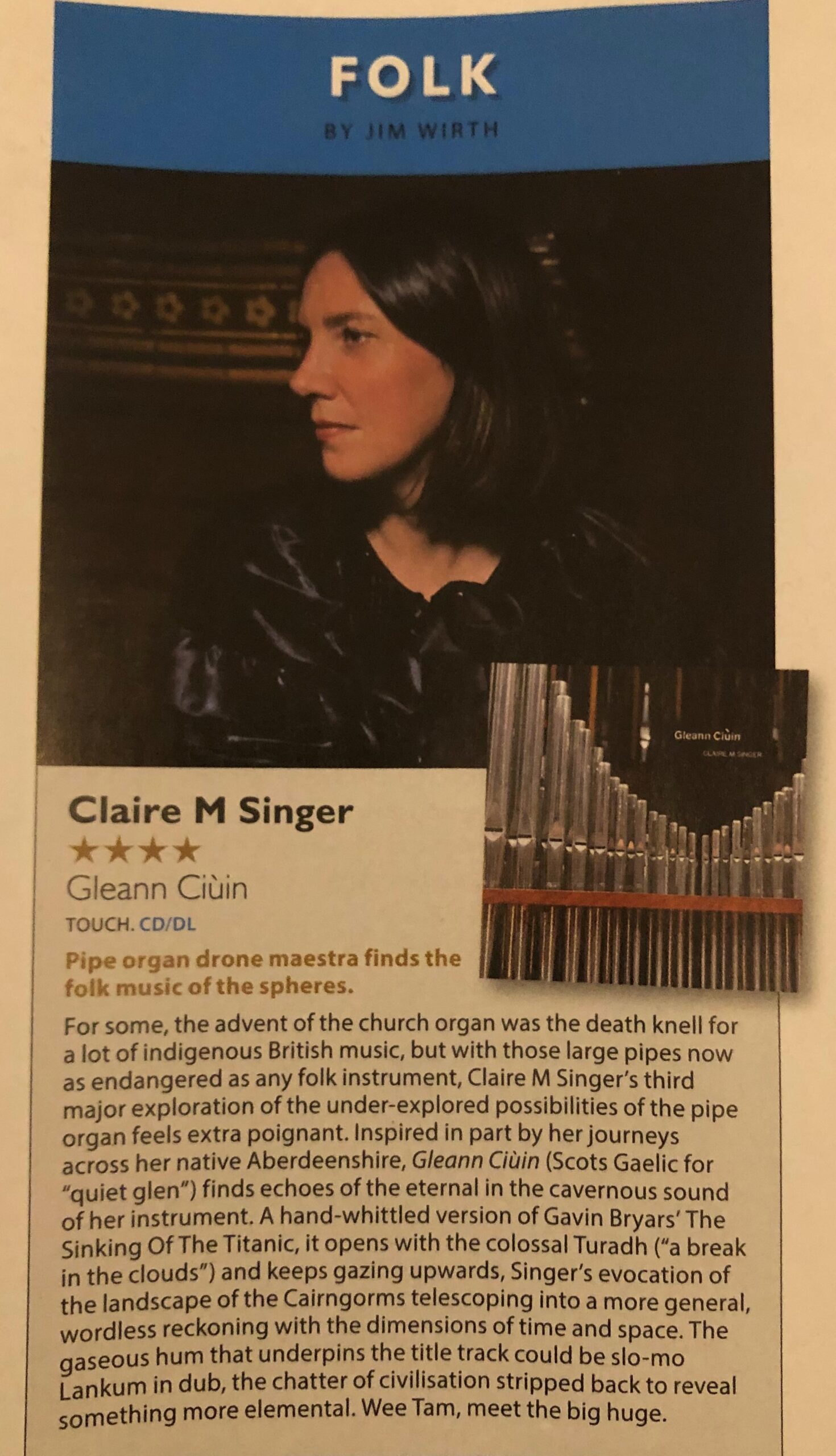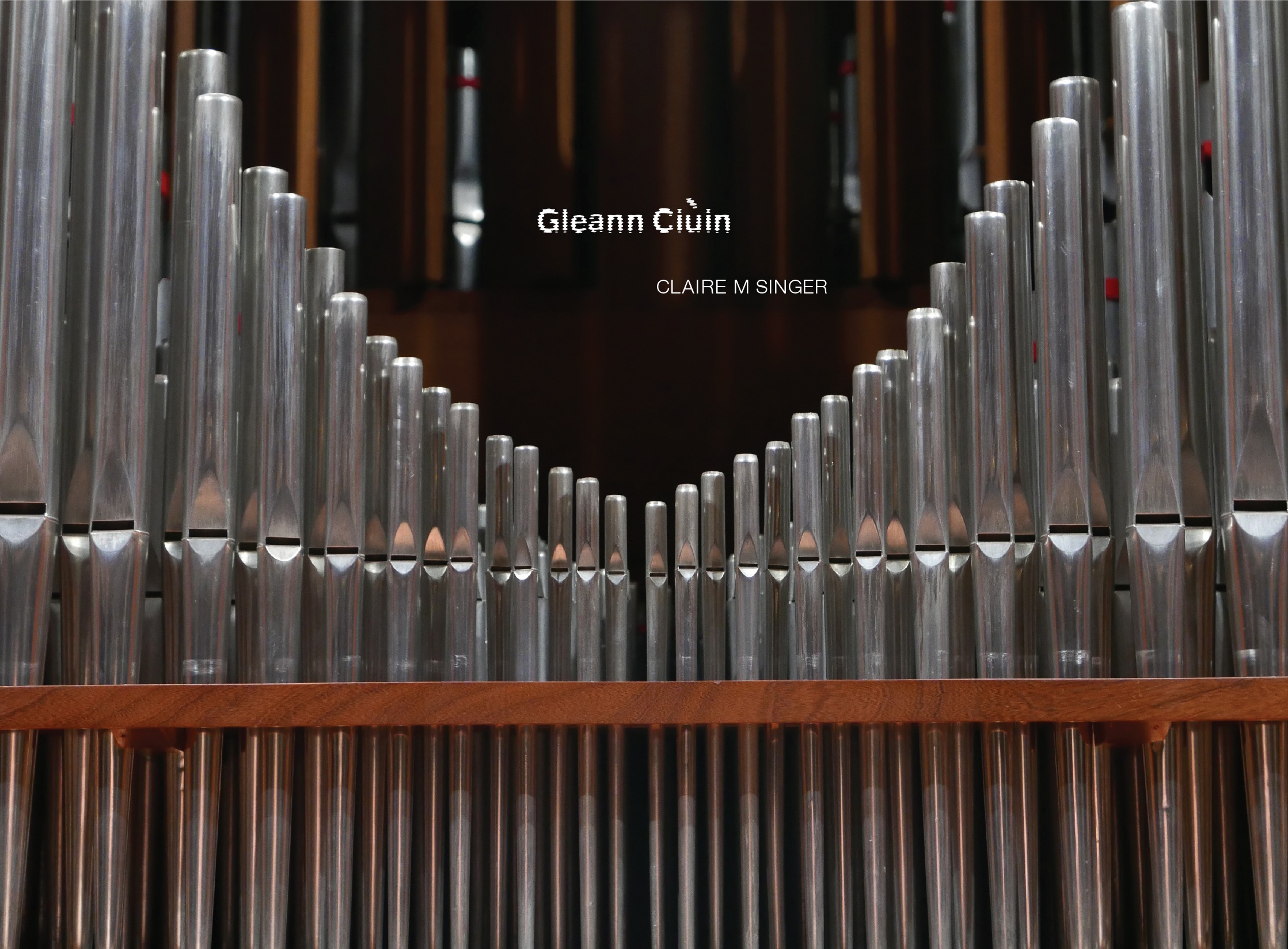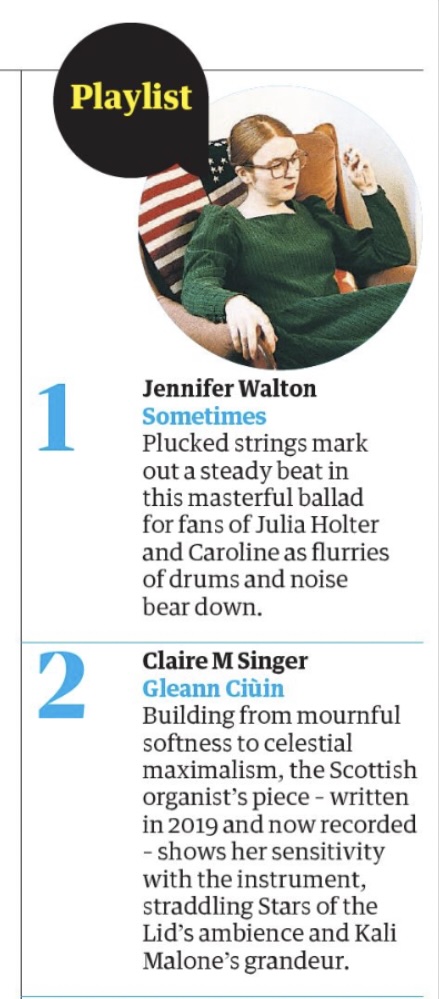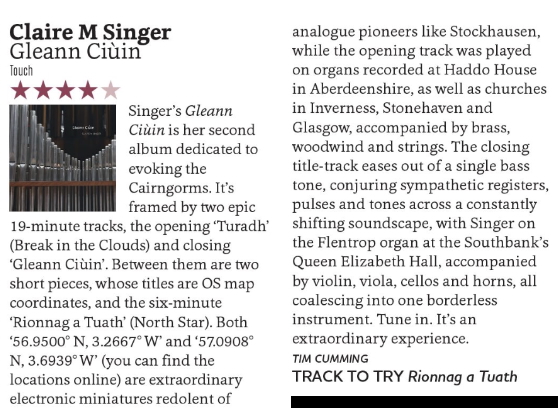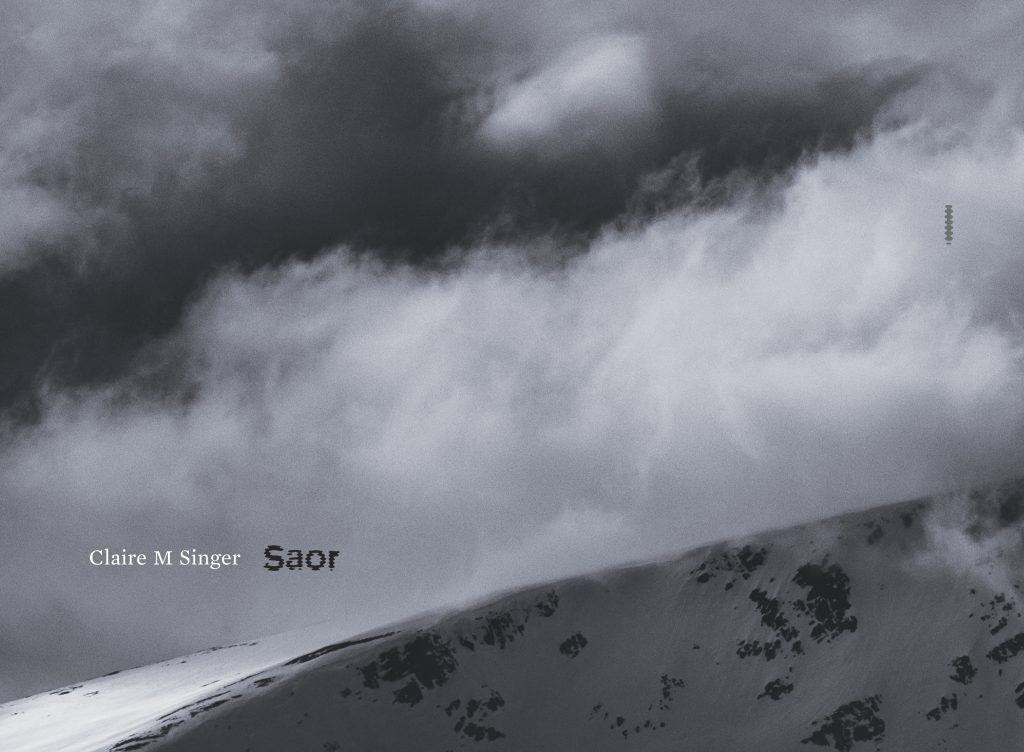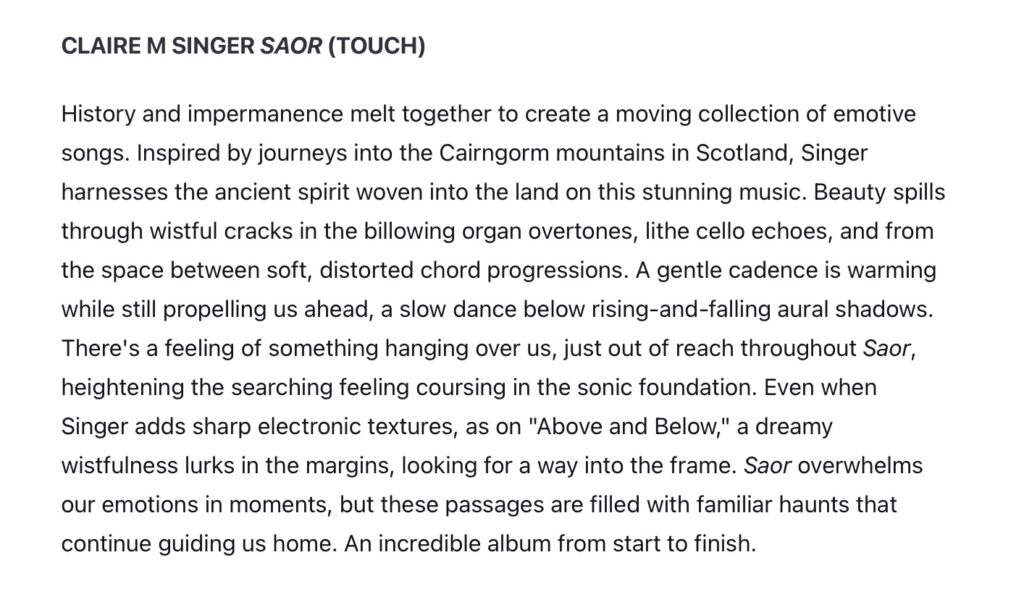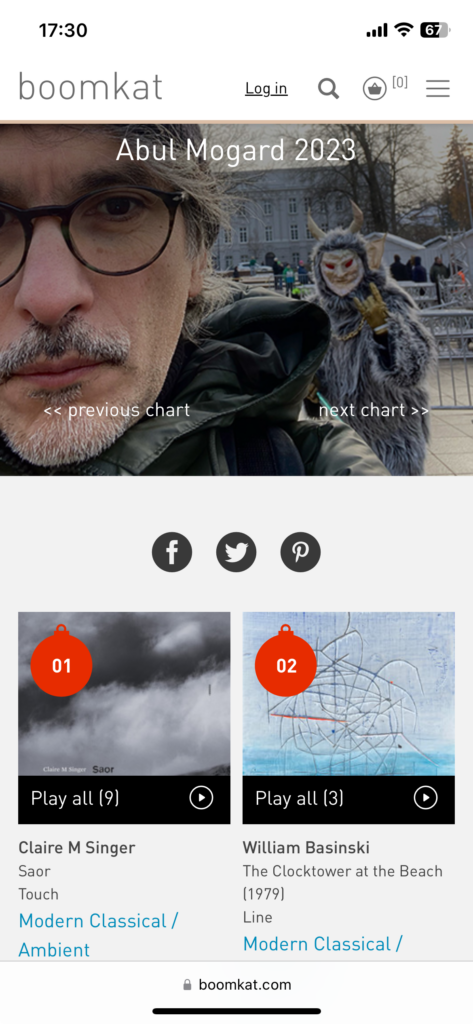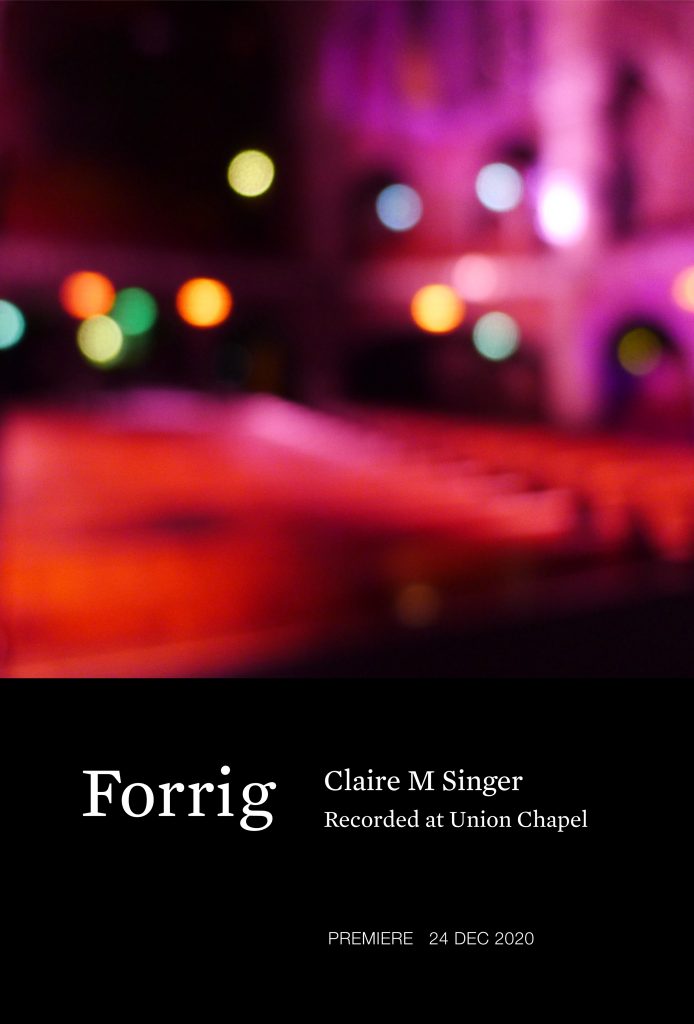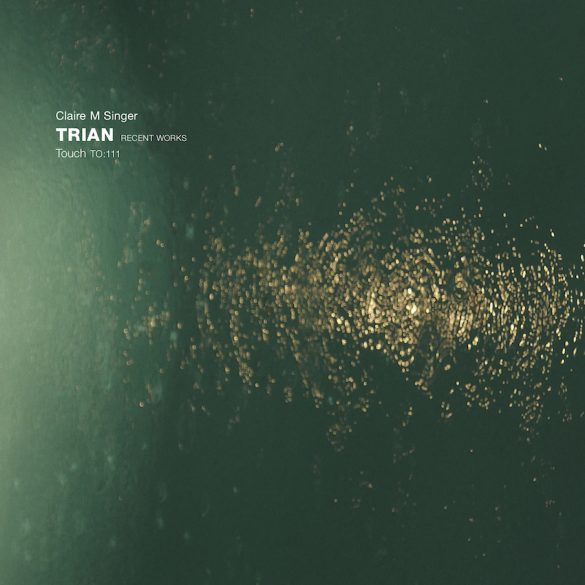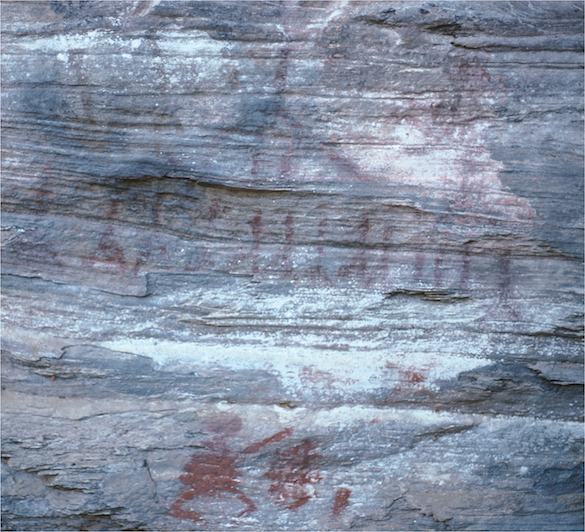Claire M Singer – Fairge [Touch # Tone 59]
CDEP – 1 Track – 20:55
Limited edition in CD wallet
Written & performed by Claire M Singer
Mastered by Denis Blackham @ Skye
Photography & design by Jon Wozencroft
Recorded by Clare Gallagher at Oude Kerk, Amsterdam, 12th June 2017 on the transept organ built by Ahrend & Brunzema (1965). ‘Fairge’ was commissioned by Oude Kerk for ‘Silence’, a concert series curated by Jacob Lekkerkerker.
Following 16 months after Scottish artist Claire M Singer’s debut album comes the release of the beautiful and intriguing ‘Fairge’, meaning ‘the ocean’ or ‘the sea’ in Scottish Gaelic. ‘Fairge’ is a single 21-minute piece for organ, cello and electronics, composed, performed and produced by Claire and is very much a companion work to the title track on her debut album ‘Solas’ (Touch, 2016).
Commissioned by Amsterdam’s oldest building and parish church Oude Kerk, ‘Fairge’ premiered at the church in February 2017. Claire M Singer’s performance on the Ahrend and Bunzema organ, cello and electronics is truly captivating. The work very much encapsulates her signature style of expansive soundscapes full of intricate textures, rich overtones and powerful swells, emotionally resonating from beginning to end.
‘Fairge’ was written specifically for the Ahered and Bunzema organ and explores the precise control of wind through the pipes using mechanical stop action. This creates a lush harmonic backdrop against the harmonics and melody of the haunting cello.
“Oude Kerk were very generous in letting me have time to explore and really get to know the instrument. The work was developed over many visits sitting in the church until the very wee hours over the winter months, which was incredibly magical and inspiring. When working with mechanical stops and precisely controlling the amount of air that passes through the pipes it requires a lot of practice and exploration to learn each incremental sound the organ can make and what the quirks of the instrument can be. As every organ is unique, the piece will differ on other organs but that’s what makes writing and working with the organ so fascinating. The tuning is mean-tone temperament, which I have not worked with previously. With ‘Fairge’ I really wanted to show how special this relatively small organ is and the beautiful pallet of sound it can produce.” [Claire M Singer, September 2017]
Claire M Singer’s performance is truly captivating, with her signature style of intricate textures, rich overtones and powerful swells, emotionally resonating throughout.
She is playing two special dates supporting the band Low at Union Chapel, London on the 14th October and at Westerkerk in Amsterdam on the 16th October.
The work of Claire M Singer has been widely commissioned, exhibited and performed throughout Europe and North America. This includes acoustic and electronic composition, fixed media, multi-media, installations and live electronics.
Performances and commissions include Tate Modern London; Glasgow Cathedral; Chez Poulet Gallery San Francisco; XMV New York City; Fylkingen Institute Stockholm; Ceremony Hall Austin; Kunst-Station Sankt Peter Cologne; Muziekgebouw Aan’ t ij Amsterdam and the Barbican supporting Stars of the Lid.
Claire is also Music Director of the organ at Union Chapel and Artistic Director of the Organ Reframed festival.
In June 2017 she was a recipient of the inaugural Oram Awards from the PRS Foundation and New BBC Radiophonic Workshop for her innovation in sound and music.
Reviews:
ATTN:Magacine (UK)
Claire M Singer reveals that the ocean is present within Fairge. The title comes from the Scottish Gaelic word for ‘the sea’ or ‘the ocean’. Water ripples across the album cover. And with that, I am swept into thoughts of the water as her music gathers from layers of cello, organ and electronics. Those held organ chords trace the horizon line, shimmering as moonlight skates across it. Overtones bulge and recede like those tiny, transient waves that bring the entire surface into motion, fleeting to the point of illusory. And then, less materially, I feel the optimism of peering into the void, facing away from the frank and firm surfaces of terrestrial concern, absorbing a view whose flux is a rich, ever-renewing state of possibility, mesmeric for its absence of endings and limits. ‘Fairge’ is, after all, seemingly edgeless. Stereo space is not the breadth to which sound must abide but the mere brink of what my ears can perceive, and I imagine these drones to stretch far beyond what can be fathomed by the context of recorded audio.
And so as ‘Fairge’ rouses itself unevenly – upon wavering, almost discordant clouds of breath and shrill whistle – I take it that it is me, the listener, who is the cause of this bleary beginning, my hearing still soft and distant as I awake. The chords deepen. The detail starts to crystallise. Pitches begin to stabilise. ‘Fairge’ becomes less a cluster of unsympathetic hums, and more a single organism surging back and forth as a coherent whole as my mind starts to perceive it as such: the surface bristling with small cyclical movements, the low frequency depths surging between greater tidal changes. The longer I listen, the more I start to imagine the presence of voices within the flow, peripheral perception teased by those little quivers of water. And while the piece might technically be a mere 20 minutes long, it ultimately rolls out across eternity. Like a stretched out pop song, each chord is pitched as a heartfelt beckoning of the next, gifted movement from the interplay between longing and fulfilment. Again, the conclusion of ‘Fairge’ is rather a symbol of my departure. The ocean melts as my senses slip toward slumber; still present, but silent. It will still be there when I return.
Ondarock (Italy):
Con i suoi trentacinque anni di storia, Touch è sempre stato e ancora rimane uno dei principali avamposti per la scoperta di nuovi talenti della musica sperimentale e della sound art. Solo nel 2016 l’etichetta londinese ha dato alle stampe gli esordi su disco di due giovani compositrici emergenti della scena britannica: Bethan Kellough (‘Aven’, Tone 54) e Claire M Singer (‘Solas’, TO:101), entrambe interessate a favorire un dialogo spontaneo tra ambient/drone e neoclassicismo.
Il nuovo live in edizione limitata di quest’ultima, capitolo afferente alla serie Tone, è stato commissionato e registrato presso la chiesa parrocchiale Oude Kerk, ad Amsterdam, nel febbraio del 2017. ‘Fairge‘, termine del gaelico scozzese che indica il mare o l’oceano, è un breve quanto efficace studio sul rapporto tra tono continuo e composizione melodica.
Diversi autori contemporanei si sono dedicati al disvelamento del potenziale poetico di elementi essenziali come bordoni e onde corte, da Matthew Earle al radicalismo di Michael Pisaro, sino alla recente e affascinante raccolta di Chiyoko Szlavnics su Another Timbre (‘During A Lifetime’, 2017).
Prima ancora che l’interazione tra le due dimensioni sonore, Singer mette a frutto il loro contrasto netto: a tre minuti occupati da un lievissimo accumulo di linee statiche e convergenti, d’organo e di violoncello, segue una graduale moltiplicazione che sposta idealmente l’asse acustico centrale e lo propaga in ulteriori direzioni. Si genera così un equilibrio armonico tanto solido quanto aggraziato, un bilanciamento la cui esattezza risale agli albori della musica sacra, in cui l’intonazione di antifone e salmi già poggiava su un basso continuo, ma che si ricollega al presente in una distinta consonanza con le tessiture ambient degli Hammock e le sezioni d’archi dei Sigur Rós più estatici.
Ultimato in seguito a numerose visite in loco, oltre a rappresentare un lodevole esercizio di sintesi ‘Fairge’ ispira la lieve commozione di una luce pura che riveste una parete altrimenti spoglia – suggestione che può addirittura prescindere dalla specificità della sede cultuale, tanta è la sua immediatezza. [Michele Palozzo]
Exclaim (Canada):
Scottish contemporary composer Claire M Singer follows the patient beauty of her debut album, ‘Solas’, with this epic, nearly 21-minute single-track EP conceptualised around the Scottish Gaelic word for ‘ocean’.
‘Fairge’ continues Singer’s fascination with carefully textured drones and the gradual mutation and intensification of repetitive parts. With gripping deliberation, she thickens the organ-driven frequency spectrum with layers of electronics and cello over the piece’s majestic, undulating and swelling runtime. When a simple note-diving hook enters around the 11-minute mark, the sound has congealed so much that it’s hard to tell which instrument or combination is causing it, but the effect makes a most effective and chilling climax to the piece.
After this subtly roiled sonic ocean churns up those delicate whitecaps, the quelling comedown is long, soothing and rife with the attentively nurtured minute timbral warbles that make Singer’s music important to listen to on high end speakers. A compelling continuation of the instrumental conversation she started on ‘Solas’, ‘Fairge’ is ample evidence that this compelling new voice in minimalist modern classical composition has a lot more to say.
Chain D.L.K. (USA):
Described as a companion piece to the title track from her debut album ‘Solas’, ‘Fairge’ is one twenty-minute work commissioned and written primarily for the relatively small Ahered and Brunzema organ in Oude Kerk, Amsterdam’s oldest building. Long, sustained and mesmerising organ chords are decorated by the addition of modest and sympathetic cello and electronic layers to create a deceptively simple sonic carpet.
Occasional chord changes and a gradual sense of tonal shift that at times feels like a Shepard tone effect result in something that seems static at first, but which under the surface, is never standing still. A two-note pattern slowly reveals itself in the upper register that over time transforms into a plaintive unanswered call.
Seventeen minutes in, a gradual cessation begins in which the purest organ tones are slowly left alone in their own space, a fade which continues beyond our hearing into a final minute which is essentially silence.
Fairge is Gaelic for the ocean, and if this is an evocation of the sea, it’s a very calm, sedate and empty moonlit plateau.
It’s a bold and beautiful work that, on first listen, made me sign up to Singer’s mailing list with immediate effect, and want to check out ‘Solas’ at the first opportunity.
Artnoir (Germany):
Und jetzt zu etwas komplett Anderem: Eine 20-minütige Komposition für Orgel und Cello, ein kontinuierliches Anschwellen an Klangschichten, ein hypnotisches Stück Musik zwischen Experiment und Ambient. Was die schottische Künstlerin Claire M Singer mit ‘Fairge‘ vorlegt, ist genauso träumerisch und unwirklich wie geerdet und emotional. Knapp ein Jahr nach ihre Debütalbum ‘Solas’ wird der Kosmos dieses jungen Talents gefühlvoll erweitert und ist nicht nur für Denker interessant.
‘Fairge’ ist als Lied wie als Konzept eine Reise und beginnt in kompletter Stille. Ganz sachte lässt Claire M Singer die Instrumente in das Bewusstsein des Hörers treten und verfeinert die Töne mit Elektronik. Was zuerst wie etwas unheimliche Field Recordings wirkt, bläht sich mit jeder Minute zu einem grösseren Klangkörper auf und man bemerkt: Dies sind Orgelnoten, welche schier pausenlos gehalten werden. Schwermütig, aber immer zaubervoll vom Cello umgarnt, steigt man zusammen mit der sich steigernden Lautstärke in die Höhe. Und spätestens ab der Hälfte des Liedes findet die Katharsis statt.
Claire M Singer scheut sich nicht, meist eher veraltet anmutende Instrumente in experimentelle Formen zu bringen und mit wenigen Veränderungen in der Komposition extreme Wirkungen zu erzielen. ‘Fairge‘ ist somit eine ergreifende Erfahrung und sowohl für Leute perfekt, denen Anna Von Hausswolff immer etwas zu bedrohlich erschien, für die die Orgel im Soundtrack zu ‘Interstellar’ dann aber doch zu selten aufspielen durfte. Und wenn am Ende die Musik langsam wieder aus unserer Wahrnehmung verschwindet, so bleibt das Gefühl der Vollkommenheit. [Michael Bohli]
Westzeit (Germany):

Rockerilla (Italy):
La poetica della meccanica, un suono unico davanti al quale si abbassa il capo chiudendo gli occhi nel rispetto della bellezza. Claire M Singer suona l’organo, un particolare modello di organo fabbricato artigianalmente da Ahrend e Brunzema. Uno strumento che si trova, nella versione con 17 registri, anche nella prestigiosa Oude Kerk di Amsterdam, lì dove a Febbraio la musicista ha presentato per la prima volta questo lavoro dal vivo. Solamente una traccia, venti minuti che si espandono per una durata indefnita, travolgendo l’ascoltatore con immense ondate schiumanti commozione, la stessa che si prova guardando lo spazio sconfnato dell’Oceano, Fairge in lingua gaelica. MAGICO. [Mirco Salvador]
ambientlog.net:
Fairge (meaning ‘ocean’ or ‘sea’ in Scottish Gaelic) is a 21 minute composition for organ, cello and electronics written and performed by Claire M Singer.
The piece is commissioned by the Oude Kerk in Amsterdam (the city’s oldest building, now a museum), and was written especially for its remarkable Ahrend and Brunzema organ. “As every organ is unique, the piece will differ on other organs but that’s what makes writing and working with the organ so fascinating.”
‘Fairge‘ builds up slowly, starting from the sounds of the breathing organ pipes, then introducing an almost shy cello accompaniment gradually gaining confidence and moving to the foreground. Getting stronger and louder (like ocean waves in a storm) – a massive and impermeable sound dominated by the sound of the church organ – ‘a lush harmonic backdrop against the harmonics and melody of the haunting cello’.
The sound of a church organ in full power can make man feel humble and small, and so does this ‘expansive soundscape full of intricate textures, rich overtones and powerful swells.’
The wind through the pipes of this organ can be precisely controlled using mechanical stop action. When the piece ends – the ocean storm retreats – one can hear the last breaths of air leaving the church pipes: the powerful dominance gone and replaced by a feeling of uncertainty that creeps back in together with the surrounding silence. [Peter van Cooten]
Gonzo Circus (Belgium):

Groove (Germany):
Zum Abschluss der Kolumne und der Jahreszeit angemessen gibt es heuer wieder eine vollendete Schöpfkelle purer Transzendenz. Das Zweitwerk der schottischen Organistin und Komponistin Claire M Singer, Fairge (Touch), ist ein einziger langwelliger, von subtilen elektronischen Echos umflorter Orgeldrone, der in zwanzig Minuten von dunkel glimmendem zu brillant gleißendem Schönklang und wieder zurück führt. Diese erhabene Breitseite von Kraft und Anmut hat zwar enge Verwandte wie Charlemagne Palestines Schlingen Blängen, ist in der durchgehaltenen klanglichen Schönheit und Liebenswürdigkeit aber doch gigantisch.
Pfeiltasten Hoch/Runter benutzen, um die Lautstärke zu regeln.
P.S. Im Winter um die Jahreswende 2017/2018 wird Singer ‘Fairge‘ in verschiedenen europäischen Kirchen aufführen. Nicht verpassen!
Blow UP (Italy):
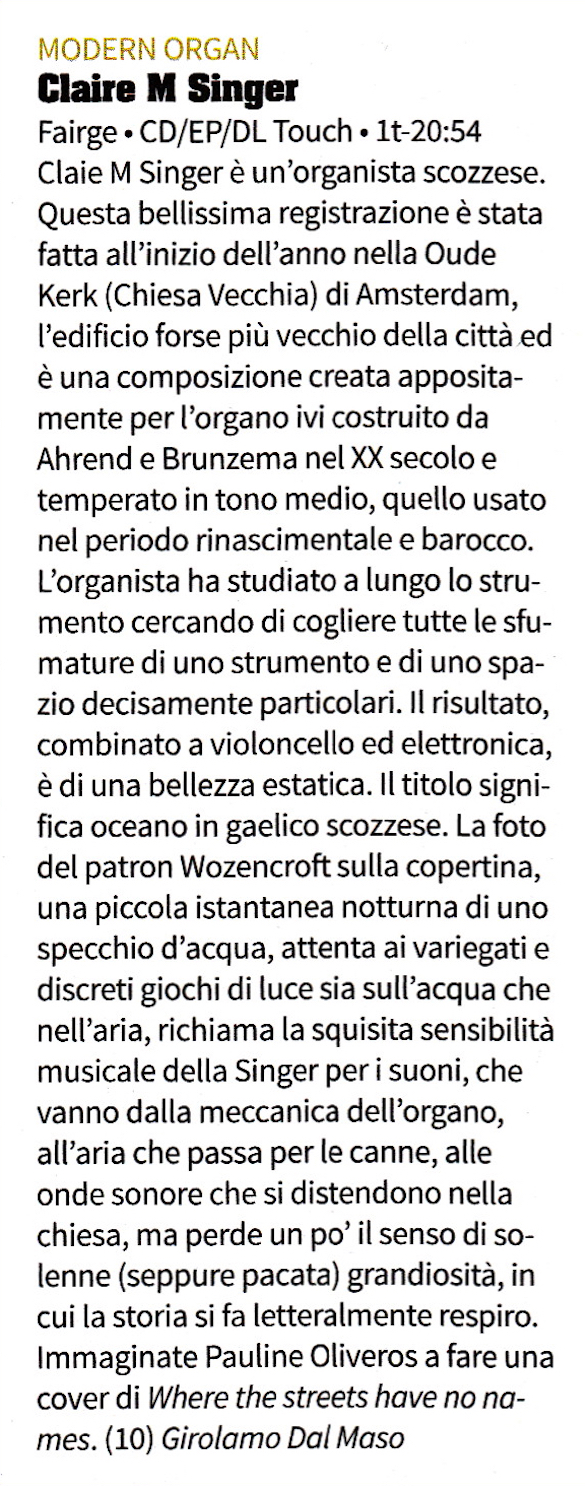
RNE (Spain):
El Nuevo trabajo de la artista escocesa Claire M Singer, ‘Fairge‘, llega 16 meses después de su debut.
‘Fairge’ significa ‘océano’ o ‘mar’ en gaélico escocés y es basta como él, una pieza única de 21 minutos para órgano, cello y electrónica, compuesta, presentada y producida por Claire, en gran parte un trabajo complementario al tema principal de su álbum debut ‘Solas’.
‘Fairge‘ fue encargado por el edificio más antiguo de Ámsterdam y la famosa iglesia parroquial Oude Kerk, en la que se estrenó en febrero de 2017.
‘Fairge’ encapsula el característico estilo de Claire con sus paisajes sonoros expansivos llenos de texturas intrincadas, ricos matices y potentes oleajes, que resuenan emocionalmente de principio a fin.
‘Fairge‘ fue escrito específicamente para el órgano construido por los famosos Jürgen Ahrend y Gerhard Brunzema y explora el control preciso del viento a través de las tuberías mediante acción mecánica. Esto crea un telón de fondo armónico exuberante contra los armónicos y la melodía del violonchelo inquietante.
Además de su carrera como compositora e intérprete, Claire es también directora musical de órgano de la Union Chapel y directora artística del festival Organ Reframed.
En junio de 2017, recibió los Premios Oram de la Fundación británica PRS y el New BBC Radiophonic Workshop por su innovación en sonido y música.
Loop (Spain):
After her debut album ‘Solas’ (Touch, 2016) the Scottish artists Claire M. Singer released her ‘Fairge‘ EP which in Scottish Gaelic means sea.
This work was commissioned by the parish church Oude Kerk (the oldest building in Amsterdam) and was specially composed for the Ahered and Bunzema organ.
‘Fairge‘ is a single 21-minute organ, cello and electronic track that starts very slowly with the pulsation of a chord, and then another is added producing a slight change of tone, as if it were the opening to an epic piece of work. The cello emerges timidly while the electronic layers are submerged as a backdrop.
The organ with its precious pipes is closer to heaven than earth and its music thrills for its heavenly and inspiring beauty. [Guillermo Escudero]
Beat (Germany):
Sogar eine so großartig pro- duzierte EP wie ‘Fairge’ kann nur ansatzweise die Klang-macht, Fülle und Zauberweltlichkeit vermit- teln, welche die Kompositionen von Claire Sin- ger auf ihrem liebsten Instrument und in ihrer bevorzugten Umgebung entfalten: Der Orgel der Londoner Union Chapel. Mit einfachen, mecha- nischen Mitteln – Pedale und Register, sparsame Akkordtektonik, das Fortschreiten im Tempo ih- res Herzens, abseits von Clicktracks und weltli- cher Zeit – scha t Singer eine Musik, die Ruhe und Kraft ausstrahlt, aus Limitierungen unge- ahnte Möglichkeiten extrahiert und zugleich vertraut und zutiefst mystisch anmutet. 21 Mi- nuten Kontakt mit etwas, das sehr viel Größer ist als wir.
